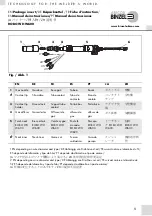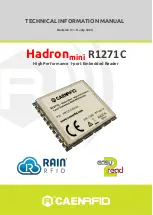
Page 8
BUDGIT Air Hoists are for the most part simple periodic
inspection procedures to determine condition of hoist
components. Below are suggested inspection procedures,
based on daily average hoist usage.
Hoist subjected to severe service or to adverse
environments should be examined weekly or as conditions
warrant.
5-2. THIRTY-DAY INSPECTION. Hoist may be left suspended.
a. Inspect Load Chain.
(1) Operate hoist under load and observe operation of chain
over sprocket in both directions of chain travel. Chain should
feed smoothly into and away from the sprocket. If chain binds,
jumps or is noisy, first see that it is clean and properly lubricated.
If trouble persists, inspect chain and mating parts for wear,
distortion or other damage.
(2) Coil Type Load Chain. Clean chain for inspection.
Examine visually for gouges, nicks, weld splatter, corrosion or
distorted links. Slacken chain and check bearing surfaces
between links for wear, Figure 5-1. Greatest wear will often
occur at sprocket at high or low point of lift, particularly when
hoist is subjected to repetitive lifting cycles. Case hardness of
chain is about .015" deep. Chain must be replaced before the
case is worn through. Also check chain for elongation using a
vernier caliper (Figure 5-2). Select an unworn, unstretched
section of chain (usually at slack or tail end) and measure and
record the length over the number of chain links (pitches)
indicated in Figure 5-2. Measure and record the same length of
a worn section in the load side of the chain. Obtain the amount
of wear by subtracting the measurement of the unworn section
from the measurement of the worn section. If the result (amount
of wear) is greater than the amount specified in the
“ALLOWABLE CHAIN WEAR” table, the chain has elongated
beyond the maximum allowable length and must be replaced.
Chain with excessively pitted, corroded, nicked, gouged, twisted
or worn links should be replaced using only factory approved
chain. Never weld or attempt to repair coil chain.
Load chain for spark resistant models is made of stainless steel.
Surface hardness treatment is no more than .001" deep and
the core is lower in hardness than standard alloy steel load
chain. For these reasons the rated capacity of spark resistant
models is lower than that of standard models as follows:
Lines of
Load Chain
Rated Load for
Standard Model
Rated Load for
Spark Resistant Model
1
1/4 Ton
—
1
1/2 Ton
3/8 Ton
2
1 Ton
3/4 Ton
ALLOWABLE CHAIN WEAR - ELONGATION
Chain Size
(Wire Dia.)
No. of Pitches
to Measure
Maximum
Wear Limit
1/4"
13
.145"
Do not assume that load chain is safe because it measures
below replacement points given herein. Other factors, such
as those mentioned in visual checks above, may render
chain unsafe or ready for replacement long before
elongation replacement is necessary.
CAUTION
(3) Roller Type Load Chain. Visually check for possible
twists, broken links, wear or elongation. Check roller chains
for elongation from wear by pulling chain taut and measuring
as follows: On RC-625 or H-5 size chain (5/8" pitch), measure
distance over a length of 20 pitches (center-to-center distance
between 21 rivets) - it must not exceed 12-3/4 inches. If chain
exceeds this limit, replace damaged section or install new
load chain assembly. Check chain for twist. If twist in any 5'
extension exceeds 15° replace chain. Check chain for camber.
If any section has side bow exceeding 1/4" in five feet, replace
chain. Use only factory approved chain. If chain is to be spliced
to replace damaged section, it is recommended that this be
done by a recognized BUDGIT Repair Station, since splicing
link must have a spun head requiring special tools. Spring
link must not be used except to secure the tail chain to the
hoist frame. (See Figure 7-1.)
Figure 5-2. Checking Coil Chain Using Vernier Caliper.
Figure 5-1. Check Chain Wear at Bearing
Surfaces Between Links.
It must not be assumed that load chain is safe because it
measures below replacement points given herein. Other
factors, such as those mentioned in visual checks above,
may render chain unsafe or ready for replacement long
before elongation replacement is necessary.
CAUTION
When replacing coil load chain, use only factory
approved chain conforming to factory specifications
for material, hardness, strength and link dimensions.
Chain not conforming to BUDGIT hoist specifications
may be dangerous as it will not fit in the load sprocket
and chain guide correctly, causing damage to hoist
and it will wear prematurely, deform and eventually
break.
WARNING









































